How to Meditate
Enjoy the new video clips that demonstrate the various exercises described below.
To view the complete meditation instruction video, please click here.Note: These instructions are drawn from the vipassana traditions of Mahasi Sayadaw and Chao Khun Bhavanapirama Thera. It is assumed that the reader is familiar with the essay, What is Vipassana?
This article offers step-by-step instruction for nine insight meditation exercises, as well as a detailed explanation of mindful eating, hints on dealing with problems such as wandering mind, sleepiness, disturbing mental images, unpleasant emotions, and more.
The following exercises are not necessarily listed in order of difficulty. Exercises suitable for beginners are noted. We generally recommend beginners start with the rising-falling or the hand-motions exercise. Basic walking meditation is also appropriate for beginners.
To start, choose one or two exercises and practice them daily. Even after you gain more experience, you don’t have to do all the exercises. Practicing just one of them consistently is more important.
Although these Buddhist meditation exercises come from the traditions of the Burmese teacher Mahasi Sayadaw and the Thai teacher Chao Khun Bhavanapirama Thera, you don’t have to be a Buddhist to practice them. Vipassana is a non-secular method.
[Note: This information is not meant to substitute for the guidance of a qualified instructor. Anyone serious about insight meditation should eventually find a teacher who can offer individualized counsel. In order to better understand some of the ideas presented here we recommend reading the link: What is Vipassana?]
Find a place where you can sit comfortably, without interruptions, for at least ten minutes. Although complete silence isn’t necessary— or even desirable— for insight meditation, the room should be free of obtrusive noises such as music, television, ringing phones, and nearby conversations. Even quiet talk can distract you because the mind will try to understand the words.
On the other hand, background noises like the sound of traffic, the bark of a dog or a ticking clock should not be considered hindrances, and in fact can be legitimate objects of mindfulness. Don’t wear earplugs in an attempt to “soundproof” your practice.
If you meditate in the bedroom it’s better to sit on the floor instead of the bed, which may cause sleepiness. (If you are ill or disabled, however , it is fine to practice in bed). Your sitting meditation space doesn’t have to be large. Even a walk-in closet will do.
Wear loose clothing if possible, and remove your shoes. Sometimes you might want to practice away from home (at the office, for instance) and won’t be able to change clothes. But as long as you have privacy you can loosen your belt, remove your jacket and footwear, etc.
The following postures are suitable for sitting meditation: 1. Half lotus ; 2. Full lotus; 3. Cross-legged tailor fashion; 4. Legs bent with one leg in front (Burmese style); 5. Kneeling on a meditation bench; 6. Sitting in a chair.
The first pose, half lotus, is the one most often seen in the Buddha statues of Southeast Asia. The legs are crossed and the right foot rests on the left thigh. This position is appropriate for most meditators. The next pose, full lotus, is only practical if you are very flexible. The right foot rests on the left thigh, the left foot on the right thigh.
Tailor fashion is less stable but easier than half lotus. Easiest of all the floor positions is the Burmese pose in which the legs are bent but not crossed. One leg lies in front of or “outside” the other. Both legs rest on the floor but don’t touch each other. If these postures are too difficult you can sit on a chair or a meditation bench.
When using a chair, keep your feet flat on the ground and try not to let your back touch the chair. If you need to change posture because of discomfort , do so slowly and mindfully, observing the intention to move before you shift the body. Whatever pose you choose should be comfortable enough that you can maintain it without moving for at least twenty minutes.
When sitting on the floor it will help to use a cushion. The cushion should be firm enough that it won’t be compressed flat when sat on. The ideal thickness is somewhere between two and six inches. You’ll want to experiment and find out what works best for you. Place the cushion under your buttocks with your legs touching the ground. The legs should not rest on the cushion. Elevating the hips takes stress off the neck and back vertebrae and aligns the spine, which allows you to sit comfortably for longer periods.
Regardless of which position you choose, don’t let your back slump too much. On the other hand, you shouldn’t sit so straight that you tense the body. Mind and body should feel relaxed, yet alert. Striking the right balance between the two extremes will take some experimenting. Think of tuning a violin string: it should be just right— neither too tight nor too loose.
Having found a comfortable position, put your hands in your lap, one on top of the other, with the palms facing upward. Traditionally the back of the right hand rests on top of the left palm. Don’t clench your hands. In all the exercises except walking meditation your eyes can be either open or closed (in walking meditation your eyes must be open).
We advise beginners to close their eyes, which allows for easier concentration. But sometimes concentration becomes stronger than mindfulness. In that case opening the eyes may help disperse the excess concentration and bring the two factors into balance again. Only momentary concentration is needed for insight meditation. Occasionally a meditator may experience disturbing mental images, in which case it may help to open the eyes.
Now you are ready to begin meditating. Choose one of the following exercises and practice it for at least ten minutes. Remember that all physical movements, such as walking and moving the hands, should be performed slowly, with continuous mindfulness. Shall we dive in?
Resolution
(Optional)You may wish to make a resolution before each practice-session. Doing so will help strengthen your determination. You can use your own words, but the spirit of the aspiration should be something like this: “By this practice of insight meditation may I reach the end of suffering. May others also benefit from this wholesome action.” Don’t just repeat the words; really concentrate on the resolve for a moment or two.
View video of rising and falling
or download the video.Exercise 1: Rising and Falling
(Suitable for beginners)We recommend this vipassana technique for everyone. Adopt one of the sitting postures. If you are disabled or have a chronic illness you can do the exercise lying down.
If you choose a sitting position, place your hands in your lap, palms facing upward, the right hand on top of the left. If doing the exercise lying down, put your hands on the abdomen, one on top of the other, or at your sides. Close your eyes.
Next, direct your attention to the abdomen, an inch or two above the navel. Find the point that seems clearest to you. Don’t actually look at the spot; just place your mind there. The point should lie along the vertical midline of the body.
As you breathe in, the abdomen expands; as you breathe out, it contracts. In meditation these movements are called, respectively, “rising” and “falling.” They never cease to alternate as long as you live.
As the abdomen rises, observe the motion from beginning to end with your mind. When the abdomen falls, do the same. That’s it. Just keep watching the rising-falling movements. You don’t have to do anything to them. Just know the movements without judging or describing them.
Restrict your attention to what is occurring in the immediate present moment. Don’t think about the past or future— don’t think about anything at all. Let go of worries, concerns, and memories. Empty your mind of everything except the movements occurring right now. But don’t think about the motions; just know them.
It’s important to understand that knowing physical motion (or any phenomenon) as it actually is in the present moment is entirely different from thinking about it. In insight meditation the aim is not to think, but only to know.
To know an object during vipassana meditation means to experience it with bare, nonverbal awareness. You merely register the sensation with impartial attention, without identifying, naming, judging or describing it. So you don’t have to comment on the movements: “That falling motion lasted longer than the previous one. That rising movement wasn’t as clear as the others,” and so on.
As soon as there is bare awareness of the rising or falling movement , you are already knowing it. The same is true of everything you might observe during practice. No matter what appears, just know it with bare attention for one moment, then let it go.
Keeping your mind on the rising-falling movements may not be as easy as you think. Be patient and don’t judge yourself, even if the mind wanders out often. Remember that you’re learning a new skill. When learning to play the piano, for example, you wouldn’t expect perfection right away. Likewise, you shouldn’t expect it in meditation. Don’t get discouraged if your progress seems slow. As long as you stick with the practice, results are sure to come.
As a beginner, you should label the abdominal movements with a mental note. A mental note— also called a “label”— is a word or short phrase said silently in the mind at the same time you notice an object. The practice of mental noting helps keep the mind on the meditation object and prevents it from getting distracted. But this technique is only a temporary crutch. The mental notes should be dropped when mindfulness is strong enough to observe objects without them. In fact, the labels will fall away on their own when no longer useful.
Labeling an object with a mental note should not be confused with recognizing and inwardly repeating the conventional name of the object (as we do in daily life as soon as we see or hear something), or describing the object further. Mental notes support mindfulness in the early stages by aiding the development of momentary concentration. But even when using the noting technique, you should focus on the bare sensation of knowing the object, letting go of the conventional names, associations and meanings that in ordinary life are automatically attached to sights, sounds, and so on.
Here’s how to use the noting technique with this exercise: As the abdomen expands, say the word “rising” in your mind. When it contracts, say “falling.” Continue to note rising, falling, rising, falling, from one moment to the next.
Only say the mental note one time per movement. For example, during one rising motion you would say the word “rising” once, stretching it out to last as long as the inhalation. When beginning to exhale you would say “falling,” stretching the word out to last as long as the exhalation. Again, these words are said silently. Ninety-percent of your attention should be on the actual movement instead of on the label. The aim in vipassana is to know the object itself, not the word.
The mental note should coincide with the motion, not be tagged on afterwards. Sometimes you might catch yourself saying “falling” after the rising movement has begun, or vice-versa. In that case you are no longer knowing the present moment. Just start again by noticing what is actually happening now. Later we’ll talk more about mental notes.
During the rising-falling exercise, focus on the movement— the subjective experience of motion— instead of on the physical abdomen itself. Motion is perceived as a subtle sensation of tactile pressure. That sensation keeps changing from moment to moment. Your job is to keep being aware of this changing phenomenon in real-time, from second-to-second. That’s all you have to do.
If it is difficult to perceive the rising-falling motions you can put both hands on the stomach to help you feel the movement more clearly.
The abdomen should not be visualized. You only have to know the movements.
Be sure to breathe naturally; don’t try to control the breath in any way.
If you can watch your abdomen rising and falling one time, you can practice insight meditation. Why not try it right now before you continue reading? It will only take a few seconds.
Close your eyes and observe one rising motion; then observe one falling motion. Don’t worry— this page will still be here waiting for you. It isn’t going anywhere. After you try the exercise you can keep reading. Let any resistance drop away. Go ahead and try it now, on the count of three. One, two, three: Begin.
Congratulations. You see? Insight meditation isn’t difficult.
The rising-falling exercise is not only for beginners. Most long-term meditators continue to use it as their main practice. Even if you move on to the other exercises you should not forget about this one, since the abdominal movements can be noted anywhere, anytime.
Motion belongs to the first foundation of mindfulness, the body. The rising-falling motions are material form (in Pali, “rupa”). Regard them with a detached, scientific attitude. Realize that in the ultimate sense, these movements are impersonal phenomena, not your self. They are not the mind. It is the mind (nama) that knows them. Yet in ultimate terms the mind— what you call “your mind”— is not a self, either, but just an impersonal faculty whose function is to be aware of something.
You can practice the rising-falling exercise from ten to thirty minutes, working up to forty-five minutes or longer.
Sometimes you’ll feel bored or uncomfortable during practice. You might keep peeking at the clock, wondering how much time has passed. Another twenty minutes! How will you get through it? Even one more minute seems too much.
When that happens, limit your goal. Just take it one breath at a time. Remind yourself, “I only have to note one rising movement.” Or, “I just have to note this single falling movement. Just this much.” To let go of your resistance, worry or aversion for one moment isn’t hard (and even during those times when it isn’t easy, it’s still doable). Then do it again for one more moment. And again. In a few minutes the negative feeling will probably change by itself, because it’s the nature of the mind to change.
So don’t worry about the future during meditation practice. Let go. To think ahead, even if only to the next breath, is to move away from the present moment. Then thoughts will get stirred up— distracting, delusive thoughts about how difficult or boring meditation is. You’ll think of many things you’d rather be doing. Soon those thoughts will force you to stand up and walk away from the cushion without having finished your meditation session. It’s important not to follow those thoughts, because they are nothing but the mind’s attempt to trick you into giving up. Instead of allowing such thoughts to control you, just stay in the now; take it one moment at a time.
If meditation seems very difficult or you lack self-discipline, try this strategy: decide you will meditate just one minute per day. Anyone can do that, right? You will find, however, that once you get “over the hump” of your initial resistance and actually sit down to do it, you might sometimes want to meditate longer. It’s that initial hurdle that’s by far the most difficult. But even if you don’t end up meditating longer, keep practicing one minute every day, without exception, and your attitude will gradually change.
While observing the abdominal movements, other phenomena will sometimes intrude— thoughts, sensations of itching, pain, numbness, emotions, sounds , and so forth. In the following sections we’ll discuss how to deal with some of these objects.
Every meditation technique uses a meditation object: something you put your mind on. In the exercise given above, the rising-falling motions were the primary object. Although your attention should usually stay with the primary object, other phenomena should also be noticed at times. (We’ll explain when to notice these in a moment.) These other things are called “secondary objects.”
The word “object” has a special meaning in vipassana practice. It does not refer to a three-dimensional Thing like a desk or a bicycle. An object here is merely something that is known (something you’ re aware of) as opposed to the subject that knows it. The subject is the mind or “knower.” (Yet in the ultimate sense, the subject is not a self, but the mere faculty of knowing).
In vipassana, an object of awareness can be either material or mental. Practically speaking, a “material object” refers to a sense- impression: color; sound; odor; tactile sensation (including movement); and flavor. A mental object refers to such things as pleasant or unpleasant feeling; desire; anxiety; peacefulness; thought, etc.
As we said, while you’re observing the rising-falling movements other phenomena will be appearing and disappearing. For instance, you will be peripherally aware of sounds. Sometimes you’ll experience emotions and thoughts. You might feel itches, numbness or discomfort in the body. Or you might feel peaceful. All of these are secondary objects.
If a secondary object makes a faint impression on your awareness and does not pull your attention away from the primary object, keep your attention on the latter. In that case you don’t need to label the secondary object with a mental note. The mind will peripherally know these things as they arise, but when they do not trigger liking or disliking you don’t need to put special attention on them.
But when something “hooks” your awareness and pulls your attention away, causing desire or aversion to appear, you should label that object with a mental note.
A mental note identifies the object in general but not in detail. For example, when a sound pulls your attention away, label it “hearing” instead of “motorcycle,” “voices” or “barking dog.” If an unpleasant sensation arises, note “pain ” or “feeling” instead of “knee pain” or “my back pain.” Then return your attention to the primary object. When aware of a fragrance, say the mental note “smelling” for a moment or two. You don’t have to identify the scent.
Your eyes will usually be closed during the rising-falling exercise, so you won’t have much occasion to see. But sometimes you might want to open your eyes, as when changing posture. When aware of color, note the bare sensation of seeing for a moment or two, labeling that act “seeing.” Don’t pay attention to what the sight is an image of, or whether it’s attractive or unattractive. Then go back to observing the primary object.
Mental notes help prevent clinging and aversion from arising. But as soon as an object is noted it should be let go. Even the sensation or thought you noted one moment before should not be kept in the mind. Every phenomenon should be forgotten as soon as it is noticed.
The mental note should be limited to one or two words. If it’ s too long, another object will have arisen by the time you finish saying the label. It should also be a word easily recalled so you don’t have to search your mind for it. Don’t waste time looking for the right mental note. This will take you out of the present moment. If you don’t know what to call a certain phenomenon, just use the general label: “knowing.”
If an object has already appeared and vanished before you were able to label it, don’t go back and tag on the mental note. Let go of that past object and attend to whatever is being experienced in the present moment.
Although the labeling technique is mainly for beginners, even advanced meditators will benefit from returning to it when mindfulness and concentration are weak. Don’t be afraid to compare both procedures. Use the mental notes, then drop them for awhile. What is the difference? Are you able to stay with the present -moment object equally well in both cases? Eventually you’ll know instinctively when it is useful to use the labeling method and when it merely gets in the way.
Remember: the mental notes are said silently at the exact moment of perceiving the object, not added later.
The instructions for noting secondary objects apply to all the exercises in this article.
Your mind will sometimes wander during meditation, spinning out thoughts about the past or future. Be assured this is normal; but what should you do when it happens? The strategy is simple: When you catch yourself thinking, just note “thinking,” saying the label for a moment or two, and then gently return your attention to the rising-falling movements.
There is also another approach: if the thoughts are only faintly in the “background” and don’t snag your interest, just keep observing the primary meditation object. The thoughts will fall away on their own. The mind will still be peripherally aware that thinking has occurred, even though you won’t have labeled it.
The latter method is mainly for meditators with some experience. Beginners can try it, too; but since it is more difficult for beginners to notice when they are thinking, there is a danger they will get hooked by their thoughts and, without realizing it, get carried away on a long mental tangent. Labeling thinking with a mental note helps prevent this.
Don’t get upset or judge yourself when the mind wanders away. Keep gently bringing it back to the principal object. Be patient with yourself and understand that it’s the nature of the mind to think, so training it to stay in the present moment and just know takes time.
Actually, if you are aware the mind has wandered it means you are being mindful. If you didn’t have mindfulness, you wouldn’t know the mind had drifted away. In daily life we’re unaware how flighty and agitated the mind always is. It is only when making an effort to meditate that we can actually see the full extent of the mind’s restlessness as it jumps from one thought to the next, second by second. The suttas compare it to a monkey jumping from branch to branch.
When you catch yourself thinking you might be tempted to wonder, “How long have I been thinking? When did I stop knowing the rising-falling motions?” But those are more thoughts, and even as you’re thinking them, more rising-falling movements are passing by unnoticed in the present. Don’t go back to find the spot where you lost mindfulness or try to reconstruct the links in the cognitive chain. You can’t bring back those past moments in order to acknowledge them.
The conventional meaning of your thoughts is irrelevant in vipassana. In meditation you shouldn’t care whether the content of a thought is good or bad. During everyday life it is better to have wholesome thoughts. But all objects have equal value during vipassana practice.
That means you don’t have to feel guilty about having unwholesome thoughts. The key is to be aware of them as they arise. Everyone has bad thoughts at times. In reality most thoughts arise spontaneously due to causes we cannot directly control. Instead of trying to suppress them, the right approach is to “know and let go.”
Imagine two meditators: the first has many angry thoughts but doesn’t get involved in them. He lets them go right away. The second meditator clings to beautiful thoughts about the Buddhist teachings. Which student is practicing correctly? The first.
When a meditator is aware of a thought early enough, he realizes, “The thought was not in existence before; it appeared just now and disappeared at once. I have previously imagined thought to be permanent because I have not carefully observed it. Now that I have watched it, and seen it disappearing, I know it truly as it is, impermanent” (Mahasi Sayadaw, The Great Discourse on Not-Self, pp. 115— 6).
It is important to understand how to observe thinking correctly because, as Mahasi Sayadaw explains, thoughts and tactile sensations— especially sensations of bodily movement— are the most frequent objects of contemplation. Even exalted thoughts about the Buddhist teachings should be let go, as should painful thoughts.
When nothing else presents itself to be noticed— no sound, smell, thought, etc.— your attention should stay with the primary meditation object.
The vipassana technique involves focusing on one thing at a time. That doesn’t mean you have to observe one object exclusively for the entire meditation period. It means you know only one thing per moment. Observing two objects or sense-impressions in the same moment “confuses” mindfulness. Therefore, when observing a rising or a falling motion, don’t pay attention to sounds, thoughts, feelings or smells.
But understand that in any two consecutive moments the meditation object may be different. For example, even if you sit down to practice rising-falling for thirty minutes, it doesn’t mean you will know the abdominal movements during every single moment of that half-hour period. Secondary objects will sometimes hook you, and whenever you deliberately note a secondary object you should switch the whole of your attention to it. Whatever object is being observed at any given moment should be the only thing you direct your mind to at that time.
For instance, if a sound pulls your attention away from the abdominal movement and causes you to dislike the sound, switch your attention to the sound and note “hearing” for a few seconds. During those few seconds, ignore the rising-falling motions and all other objects and focus only on hearing (but if other phenomena are still peripherally in the background of your awareness, that’s all right. The point is that you are not intentionally focusing on them). After one or two moments of noting “hearing,” return your attention to the primary object and forget about the sound. The same procedure applies to all objects— smells, thoughts, itches, emotions, pain and so on.
During vipassana practice you might feel an itch somewhere on the body. In daily life sensations of itchiness arise frequently, but since our normal response is to scratch the itch unconsciously, without clear mindfulness, we don’t realize it happens hundreds of times per day. During meditation you begin to see that uncomfortable bodily sensations arise much more often than you thought.
If you can keep your attention on the principal object and let the itch stay in the “background,” it will often disappear by itself. If it doesn’t and becomes uncomfortable, just watch the sensation for a few moments, saying the mental note “feeling” or “itching.” Desire might arise— desire to be rid of the feeling. Label this “wanting” or “desire.” (Here you don’t observe the sensation of itchiness per se, but the wanting, which is a different object).
If the itch persists and you have to scratch it, use the following step-by-step technique:
- Observe the desire to be rid of the feeling, saying the mental note “desire.”
- Before moving your hand, note “intending to move.”
- Slowly move your hand to the itchy spot, noting “moving.”
- Pause for a moment (i.e., stop moving completely for a second or two).
- Begin to scratch, noting “moving” or “scratching.”
- Pause before moving your hand back to your lap.
- Move the hand back, saying the mental note “moving.”
- Pause again before placing the hand in your lap.
- Place the hand in your lap, noting “placing.” Now you are back to the original meditation posture.
- Note the pleasant feeling that has replaced the unpleasant one, labeling it “feeling” for one or two moments. Notice if liking arises for the good sensation. If it does, label it “liking” or “desire.”
- Resume watching the rising-falling motions.
When you keep the body in the same position without moving it, sooner or later pain or numbness will arise. How should you deal with pain during meditation practice?
Instead of automatically shifting the body when you feel discomfort, try to observe the sensation itself, labeling it with the mental note “pain” or “feeling.” Sometimes the pain will disappear on its own. Sometimes it will grow stronger first, then diminish or disappear. In any case, by observing unpleasant feeling you will notice that it does not stay the same. It changes from moment to moment. Like everything else, pain is impermanent.
But if the pain becomes too severe you should change your pose. Beginners shouldn’t try to grit their teeth and tough it out. Only advanced meditators can observe severe pain effectively. The object is too heavy for a beginner’s mindfulness to “lift.”
On the other hand, you don’t want to change position at every little twitch or tingle. Don’t give in to desire easily. Progress will not come without the patience to bear many unpleasant feelings. Only change position if you cannot tolerate the discomfort and it is interfering with your mindfulness.
If you decide to change position, follow this step-by-step technique:
- Observe the sensation of pain for a few moments.
- Note the desire to be rid of the pain. Try to let go of the desire. If possible, wait until your mind is no longer struggling against the painful feeling before you move on to the next step.
- Say the mental note “intending to move.”
- Slowly move the body into the new posture, noting “moving.” Break the entire action into several smaller movements, stopping for a moment between each one. This creates clear objects for mindfulness.
- Note the pleasant feeling that has replaced the pain, labeling it “feeling” for a moment or two. If you like the pleasure, label it “liking,” or “desire.”
- Resume watching the rising-falling motions.
By practicing insight meditation we gradually realize there is no bodily position comfortable enough that we can always maintain it. Pain inevitably appears, even when lying down (if you doubt this, ask anyone who’s bedridden in the hospital). No matter how comfortable the position initially, we are always forced to move because of the changing nature of the physical elements. That is one way in which the body is unsatisfactory, or a cause of suffering.
There is another method for dealing with physical pain, which is: disengage your attention from it and observe a different meditation object. For example, you can focus your attention on the body’s movement, whether the abdominal motions or the movement of the foot or hand (see Exercises 2 and 3).
Sometimes, even in daily life, the mind is momentarily distracted when the body is in pain. When you’re aware of the pain again, you realize that for those few moments of thinking about your finances, or the upcoming football game, or the daffodil bulbs you were going to plant, you didn’t actually feel the discomfort anymore. Why? Because the mind was occupied with something else. It’s a fact that consciousness can only know one thing at a time.
From this experience you realize that when the mind lets go of pain and focuses on a different object, the pain effectively disappears. But that’s not to say you should think and fantasize during meditation practice. The idea is to stay in the present moment, but disengage your mind from the feeling and put your attention on something else happening in the present.
With this method you let the pain be there in the background if it’s going to, but don’t pay it any attention. The attitude is that you don’t have to get involved with the pain or worry about it. The unpleasant feeling is solely the business of the body. If you can let go of the pain, you won’t feel the suffering as before. Then, even though the physical sensation may still be there, it won’t make the mind suffer with it. This method is called “changing the object.”
Generally speaking, however, feelings should be noted when they appear. This is not only true of unpleasant feeling. It is important to know and let go of pleasant feelings, too. If you fail to do so, attachment can arise. Before you’re aware of it, you will cling to the feeling. You can easily get caught up in the pleasure and forget about staying in the present moment.
You should also be aware of any desire that arises in connection with feeling— whether the desire to get rid of a painful sensation or prolong a pleasant one.
Some meditators see mental vivid images when reaching a certain stage of insight. Others never see such visions. Whether or not they appear depends in part on the student’s temperament. The images might be of anything: people, animals, gardens, colors, dead bodies, skeletons, geometric shapes, etc. Some students see an image of the Buddha.
These visions can range from exquisitely beautiful to very frightening. But no matter how vivid it is, this type of image is not real. These things are mental formations that arise from imagination (coupled with concentration) and have no significance. They are neither good nor bad. The meditator should neither desire nor fear them.
If an image occurs, try to focus on the primary object again (such as the rising-falling motions), ignoring the image. Let the image remain in the “background,” but don’t pay attention to it. Eventually the image will fade away.
If an image persists and becomes intrusive, there are several things you can do:
- Try practicing with your eyes open.
- Label the image with a mental note. (You can use the mental note, “seeing,” although it should be understood that knowing a mental image is not the same as genuine seeing.) Continue to note the image from moment-to-moment until it disappears. The image will usually disappear after several notings.
- Switch to a different meditation exercise. If you are sitting, get up and practice walking meditation or do the hand motions exercise.
Be aware that if you are noting the image with the aim of getting rid of it, due to aversion or fear, it will last longer. Enjoying the vision will also make it persist. Whether it’s pleasant or unpleasant, try to note the image impartially, just as you would any other object, without liking or disliking it.
Mindfulness When Changing Posture
Insight meditators usually alternate a period of sitting with an equal period of walking meditation, especially during an intensive retreat in which vipassana is practiced many hours per day.
During the transition between postures it is crucial to maintain step-by-step mindfulness. You should resist the temptation to jump up or stretch when the sitting time is over. In the long run, even a few moments of speeding up will slow you down, because careless movements cause a break in continuity that scatters mindfulness.
In the old days, people started a fire by rubbing two sticks together until the friction produced a spark. Continuity of effort was essential in getting a flame; if you stopped to rest, the sticks would go cold and you’d have to start over. Continuity is just as important in vipassana practice.
Here we’ll describe how to move from sitting to standing in a step by step manner, enabling you to maintain mindfulness. The same principles apply when moving between any two postures.
First, note your intention as “intending to move.” Next, start moving the body slowly, breaking the motion down into a series of discrete actions. Move each hand to your stomach one at a time. Tilt your torso forward as you prepare to stand. Uncross your legs. Lift one knee, then the other. Note the feeling of pressure against each foot as you place it on the floor, and then slowly stand up.
Each of these actions should be performed slowly, methodically, and observed from beginning to end. Whenever possible, move only one body part at a time. It’s very important to stop fully at the end of each movement. Label each action with an appropriate mental note or simply note “moving.”
Once the body is upright you should observe the standing posture for a few moments, noting “standing, standing.” (This means to focus awareness on the position or shape of the body as you are standing. If this is difficult you can focus on one point, such as the pressure of the soles of your feet against the floor.)
Whether you are standing, sitting, or lying down, apply this step-by-step technique whenever you change posture during vipassana practice.
Below are a series of drawings that illustrate the reverse process, changing from standing to sitting, in even more detail. Here the process has been broken down into sixteen steps (this information has been adapted from Helen Jandamit’s book, The Way to Vipassana, Bangkok, V.H. Publications, 1990).
- Begin by standing with your feet together, arms at your sides (alternatively, you may hold your arms in front of the body, one hand clasping the wrist of the other). Move your left foot backwards, noting “moving.”
- Slowly bend your knees, noting “moving” or “down”.
- As your left knee touches the ground, note “touching”.
- Move your left hand toward the floor, noting “moving.”
- Place your left hand on the floor, noting “touching” (your hand needs to be in this position to support the body prior to moving the right leg).
- Move the right leg back until it is parallel with the left leg, noting “moving.”
- When the right leg touches the floor, note “touching”.
- Move your left hand backwards, noting “moving.”
- As your left hand touches the floor, note “touching”.
- Lower your body until you are sitting, noting “lowering”.
- Move the left foot backwards so that it is further under your body (it should be in the correct position to sit cross-legged), noting “moving.”
- Lifting the right knee, move the right foot forwards, noting “moving”.
- Reach your right arm forward and take hold of your right ankle, noting “grasping”.
- Lift the right foot, noting “lifting.”
- Move the foot towards the body, noting, “moving”.
- Set your foot on the floor, noting “placing”.
- Put your hands in your lap one by one, noting “moving.”
This series of movements is only one of many possibilities, and does not have to be followed precisely. If you have a disability or other chronic physical problem you may need to alter the steps. Adjustments will also have to be made if you meditate in a chair. The important thing is to follow the principle of breaking down your larger movements into separate, individual actions that can be noted one at a time, and to stop completely at the end of each action before beginning the next. Also, be sure to acknowledge each movement with a mental note, especially if you’re a beginner. You may devise your own notes; the ones given here are only suggestions.
Exercise 2: Walking Meditation
Walking meditation is an important vipassana technique. The basic walking meditation exercise is similar to normal walking, only slower and more deliberate. Your attention should be minutely focused on each action.
The primary object during walking meditation is the motion of the feet — with an emphasis on motion (as opposed to the physical feet per se). Observing the movement of the feet does not differ in essence from observing the rising-falling movements. If you can, mentally isolate the motion itself from the corporeal foot— the bones and muscles— and only observe the motion. ( The same principle applies to the hand motions exercise.) Though it may seem difficult at first, isolating and observing motion will get easier with practice.
Pay no attention to the abdominal movements during this exercise. As we said before, you should only observe one object per moment.
One final note: don’t look at your feet. Just be aware of the movements with your mind.
The best environment is one with few visual distractions. Remove your shoes, if possible. You should have enough space to walk at least seven paces in a straight line.
Follow the instructions on changing from sitting to standing.
Once you are standing, hold the hands in front of the body, one hand gently clasping the wrist of the other. Do not allow your eyes to look around, but keep them directed straight ahead or slightly downcast toward the floor (but don’t bend your neck too far forward. This may cause discomfort). Don’t turn your head independently. Even when you turn around at the end of the walking path, keep your head in a straight line with the body, as if you were wearing a neck brace. Relax your shoulders.
View video of basic walking
or download the video.Basic Walking Exercise
(Suitable for beginners)
- Observe the standing posture, noting “standing” for a few moments. This means to focus awareness on the posture of the body as you stand. If this is difficult you can choose one point to focus on, such as the pressure of the soles of your feet touching the floor.
- Before moving, note “intending to walk.” (Don’t skip this step).
- Slowly lift the right foot and place it down, taking one step. This should be a single fluid motion without breaks. Be aware of the entire arc of movement from beginning to end. As you do so, label the step “placing” (remember to label while the motion is happening, not afterwards). The left foot should not have moved. The left heel should still be on the ground. Pause (i.e., stop moving completely for a second or two).
- Slowly take a step with the left foot, noting “placing.” Pause.
- Continue walking, pausing for about one second between each step. Only move one foot at a time.
- When you reach the end of the walking path, place the feet together on the last step, noting “stopping.” Pause.
- Note “standing” for several moments.
- Now you will begin to turn, in four steps. Note “intending to turn.”
- Lift the toes of your right foot and pivot on that heel, turning to your right. At the same time, say the mental note “turning.” The right heel should stay on the ground. Be sure to keep your head in line with your torso. The left foot should not move. Pause.
- Lift the left foot and place it down next to the right. (The left foot doesn’t pivot, but steps). Note “turning.” You should have moved about ninety degrees. Pause.
- Pivot on the right heel again, noting “turning.” Pause.
- Lift the left foot and place it down next to the right, noting “turning.” By now you should be facing in the opposite direction, having turned one-hundred-and-eighty degrees.
- Repeat steps 1-12.
That is the basic exercise. Next we’ll give five variations in which each step is broken down into a series of smaller movements. Substitute any variation for instructions number 3 and 5 above. The rest of the exercise is the same.
A word of advice: don’t move on to the variations until you feel adept at the basic exercise. And don’t proceed to the next variation until you’ve mastered the previous one. That may take one week, one month, or longer. (During an intensive retreat, however, you might spend only one day on each variation.)
Remember that the “resting” foot should not come off the floor until the active foot has finished moving. Don’t forget to stop moving completely between each segment of a step.
Advanced Walking Meditation
View video of the two-part step
or download the video.The two-part step: (Lifting, placing). Lift the heel, noting “lifting” (the toes are still on the floor). Pause. Now move the whole foot forward and place it on the floor, noting “placing.”
View video of the three-part step
or download the video.The three-part step. (Lifting, moving, placing). Lift the whole foot straight up as a unit, noting “lifting.” Pause. Move the foot forward, noting “moving.” Pause. Place the whole foot down as a unit, noting “placing.”
View video of the four-part step
or download the video.The four-part step: (Heel up, lifting, moving, placing). Lift the heel, noting “heel up.” Pause. Lift the whole foot straight up, noting “lifting.” Pause. Move the foot forward, noting “moving.” Pause. Place the foot down as a unit, noting “placing.”
View video of the five-part step
or download the video.The five-part step: (Heel up, lifting, moving, lowering, placing). Lift the heel, noting “heel up.” Pause. Lift the whole foot straight up, noting “lifting.” Pause. Move the foot forward, noting “moving.” Pause. Stopping about an inch from the floor, lower the foot as a unit, noting “lowering.” Pause. (Be certain to stop completely here.) Place the whole foot on the floor, noting “placing.”
View video of the six-part step
or download the video.The six-part step: (Heel up, lifting, moving, lowering, touching, placing). Lift the heel, noting “heel up.” Pause. Lift the foot straight up, noting “lifting.” Pause. Move the foot forward, noting “moving.” Pause. Stopping about an inch from the floor, lower the foot, noting “lowering.” Pause. Touch the toes — only the toes— to the floor, noting “touching.” Pause. Place the heel on the floor, noting “placing.”
View video of hand motions
or download the video.Exercise 3: Hand Motions
(Suitable for beginners)This exercise is similar to walking (and rising-falling) in that you simply track the body’s physical movement. By focusing on a different part of the body, however, you give mindfulness a larger repertoire of objects, just as a weightlifter trains different muscles in rotation.
Since mindfulness sometimes gets “bored” or slows down when observing the same object for a long time (especially during a meditation retreat), changing to another primary meditation object can help mindfulness maintain strength and continuity. And because some of the movements here are shorter than in the other exercises, mindfulness is able to observe more “moments” in the same amount of practice time.
The hand motions exercise, performed while sitting or lying down, is especially useful for those who can’t do the walking practice due to illness or disability. Note: you don’t have to look at your hand. Just watch the movement with your mind.
Exercise A
- Adopt one of the sitting postures, or lie down. Place your hands on your knees, palms facing downward. (If lying down, place your hands at your sides, palms touching the floor).
- Slowly rotate your right hand laterally (to your right) until it is resting on edge, perpendicular to the knee. There should be no space between the fingers. Pause (i.e., stop moving completely for a second or two).
- Raise your hand straight up about eight inches. Pause.
- Lower the hand back down, stopping about an inch or two above the knee. Pause.
- Continue moving your hand down until the lateral side of the little finger touches the knee. Pause.
- Rotate the hand medially until the palm is resting on the knee. Pause.
- Repeat steps 2-6. Beginners should label the actions with the following mental notes: “turning,” “raising,” “lowering,” “touching,” “turning.” Practice with one hand from five to thirty minutes; then change to the other hand, giving it equal time.
Exercise B
- Adopt one of the sitting postures, or lie down. Place your hands on your knees, palms facing downward. (If lying down, place your hands at your sides, palms touching the floor).
- Slowly rotate your right hand laterally (to your right) until it is resting on edge, perpendicular to the knee. There should not be any space between the fingers. Pause.
- Raise your hand straight up about six inches. Pause.
- Pivoting from the elbow, slowly swing the hand and forearm inward toward the center of the body, stopping a couple of inches before touching the abdomen. The hand and wrist should remain in a straight line with the arm. The fingertips will now be pointing to the left and the palm will be facing the abdomen. Pause.
- Place the right hand against the abdomen. Pause.
- Rotate the left hand laterally (to your left) until it is resting on edge, perpendicular to the knee. Pause.
- Raise the left hand straight up about six inches. Pause.
- Pivoting from the elbow, swing the left hand and forearm inward toward the center of the body, stopping a couple of inches from the abdomen. Pause.
- Place the left hand on top of the right. Pause.
- Now you will repeat the motions in reverse order. Swing the left forearm out until the hand is again above the knee. The hand and wrist should stay in a straight line with the arm. Pause.
- Lower the hand straight down, stopping about an inch from the knee. The hand is still perpendicular. Pause.
- Continue moving the left hand down until the lateral side of the little finger touches the knee. Pause.
- Rotate the hand medially until the palm is resting on the knee. Pause.
- Repeat steps 8-13 with the right hand. You may label the movements with the following mental notes: for steps 2-5 and 6-9: turning, raising, moving, touching. For steps 10-13: moving, lowering, touching, turning. Practice this exercise anywhere from five minutes to one hour.
(Beginners can practice this for a few minutes before doing the rising-falling exercise. Intermediate or advanced students can practice it longer. We don’t recommend beginners practice it for the entire meditation period, because posture is a more difficult object to observe than physical motion.)
In the previous exercises you had a moving object. Here you will practice with a stationary object— the sitting posture itself (technically, however, movement is still present, because the mind moves). With your mind you are going to look repeatedly at the body’s posture, as it appears in the present moment.
Adopt a comfortable sitting position. Now, focus your awareness on the posture of the body as it sits. (Pay no attention to the rising-falling motions.) The body is adopting a form that differs from standing or lying down. This may seem obvious, but there is a difference between the vague, intermittent awareness of posture we have in daily life, an awareness interrupted by talking or thinking of a thousand things, and an attention that is wholly focused on that pose.
What you should be aware of is not a visual image of the posture, but the kinesthetic experience or “feel” of it. For instance, there is a tactile feeling when you hold the back upright as you sit. You will also experience sensations of tactile pressure at various points where your body touches the floor, or one leg presses against another.
Just “look” with your mind’s eye to know what the sitting posture is like. If it’s difficult to be aware of the whole posture at once, place your attention on one area, such as your hands in your lap. As you mentally know the posture, label the object with the mental note “sitting.” Do this once.
After you have focused one time, do it again. The method is simply to observe the posture for one moment, let it go, then bring the mind back to it again, labeling “sitting” a second time — and so on. In each moment the object, which is the posture, will appear. Watch this action — i.e., the action of the mind as it turns to look at the sitting posture — again and again. As you observe the object, be aware of the act of knowing it.
Each act or instance of focusing should be fairly quick, lasting about one-and-a-half to three seconds. Another way to think of it is that you focus for the duration of the two-syllable word “sitting,” or roughly as long as one rising motion. Then you do it again. A reminder: don’t look at the body with your eyes. Just look with your mind.
As Achan Sobin explains, it may help to think of the mind as a camera taking a series of snapshots. Take a “shot” of the sitting posture. Then take another snapshot of the same thing.
Moreover, when a photographer focuses a camera lens, he looks at one spot only; but the entire image turns out clear, not just the particular spot he focused on. (This is akin to focusing only on your hands instead of on the whole sitting posture).
Don’t keep holding the mind to the object with seamless concentration. Instead it’s an uninterrupted series or chain or individual acts of focusing. The approach is: Focus and forget it. Then immediately focus and forget it again.
But in practice the “forgetting” or “letting go” is not a separate activity. Letting go of the previous moment happens by itself every time you focus anew on the posture. So really it’s a matter of: focus, focus, focus, in a series of moments. Keep taking consecutive “snapshots” of the posture, each one lasting roughly two to three seconds.
A few pointers: don’t mentally review your whole body, piece by piece. That would take too long and would pull the mind out of the present moment. And even though you use the mental label “sitting,” remember to focus on the actual posture, not the word itself.
Every moment has two components: the object and the mind. In this case the object is the sitting posture. So you have only: the sitting posture (material form, or rupa) and the thing that is actively knowing it (the mind, or nama). The mind itself cannot adopt a posture; it can only be aware of the body’s posture. In summary: the sitting posture is material form (rupa). The mind (nama) knows — is aware of — the form.
Intermediate or advanced meditators can practice this exercise for the entire meditation period, or for a few minutes before practicing the rising-falling exercise. Beginners can do the latter.
It is natural that strong emotions may sometimes arise during meditation. If that happens, don’t assume you are practicing incorrectly. Emotions are valid objects, too, objects of the fourth foundation of mindfulness. As objects of the mind they have no more or less importance than motion or posture. They are, however, more challenging to observe.
When an unpleasant emotion such as anger arises, don’t get upset or try to suppress it. Nor should you try to look for a “better” object. The emotion is the truth of what is happening in the present, so just know it.
If an emotion is strong you should label it with a mental note. For example, if you realize you’re feeling angry, label the feeling “anger, anger” for one or two moments. If you’re depressed, note “depression”; if anxious, note, “anxiety.” Do the same with pleasant emotions: if you feel joyful, note “joy”; if peaceful, note “peace.” You get the picture.
The insight meditation method entails a middle path between 1) suppressing an emotion and 2) indulging it by: “letting it out,” trying to feel it more deeply, or thinking about it further. Whether an emotion is pleasant or unpleasant, the vipassana technique is simply to know it with impartial awareness, neither liking it nor wanting to make it go away.
Don’t judge the emotion or your self. For instance, if you’re suddenly livid, don’t criticize yourself for getting angry. Instead, disengage the mind from any involvement in the anger and just watch it, as if you were watching it happen to someone on television, or as if you were a scientist examining a specimen under a microscope. Instead of “becoming” the emotion you mentally pull back from it, then turn your awareness around and observe it. The emotion then becomes another object of your attention. Now instead of being caught up in it you’re looking at it from the outside.
Having noted the emotion for one or two moments, let go of it and bring your attention back to the primary meditation object. Over time this method weakens anger, depression, etc., since you are not “feeding” them with your thoughts and reactions. If you simply recognize the presence of these emotions when they appear but don’t get hooked by them— that is, don’t get upset or intrigued by them— they’ll eventually fade out .
When in the grip of a negative emotion we tend to believe it will never end. But in training the mind to know emotion as it is, we come to see its impermanence. Then we realize that even strong grief, anger or fear can last only a moment before passing away. True, it might come back; but even so it passes away again instantly. When you leave an emotion alone and become an impartial observer, it has no power to control you or cause more suffering. The key is to be mindful as soon as it appears so you don’t get hooked.
But sometimes beginners are so overwhelmed by painful emotion they cannot practice effectively. In that case one of the following methods may help:
- Press the fist against the center of the chest (around the heart area) and repeat “knowing, knowing, knowing,” being aware of the sensation of pressure from your hand. Keep this up until the emotion subsides.
- If you’re sitting, get up and practice walking meditation.
- Temporarily switch to a concentration technique until you are able to resume vipassana practice. For example, you might repeat the word “Buddho,” or another mantra (a mantra is a special word or phrase that is deliberately focused on in concentration meditation).
A word of caution: this last technique should not be used beyond the beginning stages of practice. Mindfulness must learn how to handle emotional objects or you won’t be able to make progress in insight. Switching to a concentration technique should not be used as a means of avoiding unpleasant emotions.
Pleasant emotions should also be known impartially, without liking or disliking. They, too, are impermanent. If you try to make a pleasant emotion stay, it will become a cause of frustration and suffering when it inevitably changes, because you’ll want to keep something that cannot endure.
An emotion of any kind is not your self or the property of self. The sadness, anger, peace, etc., is only an impersonal phenomenon, a kind of mental weather that arises in the mind according to certain causes and then passes away.
Most painful emotions spring from memory— hence the value of staying in the present moment. When recalling a painful memory— whether of a broken heart, the loss of home, health, career, or the death of a loved one— remember that the painful event that triggered the feeling is no longer actually occurring in the present. Although the event is over, we tend to cling to it in the mind. But that only generates more suffering.
Or sometimes we worry about the future, dreading the loss of wealth, youth, or health that hasn’t yet occurred. But none of these imaginings is real in the sense that none is actually happening at the moment we are thinking about it. If it did occur in the past, it no longer exists now. What might or might not happen in the future does not exist right now, either. Why should we let the mind drag us into unnecessary suffering? That doesn’t mean we shouldn’t plan for the future. But there’s a difference between behaving responsibly — doing what needs to be done— and needlessly suffering over things that may never happen, or are already gone; things which, in both cases, we cannot control. Suffering about past or future events can only arise when we fail to stay in the present. So don’t fast-forward or rewind.
Sleepiness may bother you more during intensive retreats than in your daily practice. Nevertheless, it can be a frequent hindrance for beginners. Just know that sleepiness is present when it arises. You can mentally note it as “sleepiness.” If it does not disperse after a few minutes of noting, try some skillful antidotes: open the eyes; walk instead of sit; turn up the lights, or splash your face with cold water. Cooling the room may also help. An excess of concentration can cause sleepiness. Be careful to follow the meditation techniques correctly so that mindfulness and concentration stay as balanced as possible.
It is important to understand what constitutes a correct object for mindfulness. As we explained in “What is Vipassana?” the Four Foundations of Mindfulness are the objects used. Once again, these are:
- The body: i.e., motion and posture;
- Feelings: painful, pleasant and neutral feelings (these don’t refer to emotions);
- Consciousness: for example, thinking, and consciousness with or without hatred, delusion, etc.
- Dhamma objects: mental hindrances such as lust, sleepiness, restlessness, etc.; also the five sense-impressions: sights, sounds, tastes, smells, and touches. Some objects in this group are mental, some, material.
Reduced to their essentials, the Four Foundations are simply material phenomena (rupa) and mental phenomena (nama).
In daily life our minds become obsessed with some forms and run from others. Inevitably we like good feelings, sounds and smells, and dislike unpleasant ones. Partiality reigns. But vipassana is the ultimate democratic technique. Whether good or bad in conventional terms, all objects are treated equally during insight meditation practice. Having identified the appropriate objects, we need to understand how to observe them.
In every present moment, the mind (nama) makes contact with an object. You have to observe both components. But that doesn’t mean you observe two objects at the same time. As we said earlier, in vipassana you only observe one object per moment. But you’re also aware of the knowing.
In other words, what you should observe is: the mind in the act of knowing the object. It’s not as complicated as it sounds. As soon as you’re cognizant of knowing an object, you’ll automatically be aware of the object, too, because consciousness must be aware of some thing outside itself, some phenomenon x . A moment of consciousness has to have something to know.
So when we say, for instance, “be aware of the rising motion,” what you actually want to observe is, “the-act-of-knowing-rising,” or “the mind-knowing- rising.” That is true for all the meditation objects, not just motion. The complete unit of observation is always “the-mind-knowing x.”
Another point is that objects should be observed momentarily. What does “momentarily” mean? During meditation you should only stay on an individual object— for example, an individual instance of “rising” — for one moment of time. The mind should let go of an object after observing it for just one moment.
The motto is: “Focus and forget it,” or “know and let go.” After you focus on a form, mentally release it and go on to the next one. Because, in the ultimate sense, reality is a series of different phenomena coming into being and dying one after another, your attention has to keep moving to the next thing in order to keep up. Mindfulness is always moving to know the next object that appears. It drops the previous object in order to know the reality in the next present moment.
But what if you’re observing an object that continues for a few minutes? Say, for instance, you’re observing a secondary object like a sound that goes on longer than one moment. You would observe the act of hearing for one moment, and then drop the object. Since the sound would still be going on (and provided it was still disturbing your mind), you’d observe it a second time, letting it go again — and so on, in a series of consecutive acts of knowing.
But the question might arise: Since the meditation instructions say you can practice an exercise for forty-five minutes, doesn’t your attention stay on that primary object longer than one moment? Conventionally speaking, yes. But although we can talk about continuing to observe the same primary object for half an hour or forty-five minutes, during that period of time many individual acts of noticing occur, and the mind lets go of each one in sequence.
For example, even if you continue observing the sitting posture for a total of forty-five minutes, within that period you still let go of the sitting object after each two-second moment of knowing it. Then you immediately return to the same primary object. But in the ultimate sense, every time you observe the “same” movement, sound or posture, even from one moment to the next, you are actually observing a new form. Material form such as the sitting posture is continually appearing and vanishing, even though we can’t perceive this.
In this exercise your attention switches back and forth between two primary objects. The first is the sitting posture itself, as described above.
For the second object, find a point on your right or left buttock where you can feel the contact of the floor. That will be the touching point. The idea is to “touch” this spot with your mind — i.e., to bring your awareness to focus on that point, momentarily.
Adopt one of the sitting postures. As described above, observe sitting for one moment, focusing, if you wish, on the hands in the lap. In the next moment, move your mind to the touch point and observe the contact. (Note: it is mental contact we are referring to; the contact of the mind “touching” that point.) The mind will jump from the sitting posture to the touch-point.
Keep alternating between them from one moment to the next, noting, “sitting, touching, sitting, touching.” Focus on each object for approximately the same length of time: about one-and-a-half to three seconds, or roughly as long as it takes to say the two-syllable mental note a little more slowly than normal. (Another way to think of it is that the duration of knowing “sitting” is roughly equal to the length of one rising or one falling motion. The same is true of touching.) Practice this exercise anywhere from twenty minutes to one hour.
During a meditation retreat, observe the touch point on the right side of the body for one meditation session and the left side the next, alternating sides throughout the day. In your regular daily practice you can do the left side on one day, the right side the next.
Exercise 6: Rising-Falling-Sitting
Once you feel comfortable with the rising-falling and sitting-touching meditations individually, you can begin to combine them as in this exercise. Like a juggler adding another ball, you add a third object to give mindfulness more work to do. If you have noticed a pronounced gap between the moments of rising and falling, you can try adding “sitting.”
Adopt one of the sitting postures. Observe one rising and one falling motion. Before breathing in again, focus on the sitting posture for one moment, taking a mental “snapshot” of the pose. Eventually, the duration of these three moments should be roughly equal, but when first learning the exercise it’s often uneven. That’s all right, as long as none of the moments is longer than three seconds. (Note that sitting is observed in between falling and rising, so do not breathe in while observing sitting.)
After observing sitting one time, start over with rising again. Keep going in sequence: rising, falling, sitting; rising, falling, sitting. Use the corresponding mental notes: “rising,” “falling,” “sitting.”
At first you might have to hold your breath for a moment in order to fit the sitting object between the previous falling and the new rising motion. But with practice there will be a natural space long enough in which to observe the posture. Practice this exercise for a minimum of twenty minutes, working up to forty-five minutes or one hour.
Exercise 7: Rising-Falling-Sitting-Touching
Once you feel comfortable with exercise six you can add a fourth object, combining the rising-falling and sitting-touching exercises. Adopt one of the sitting postures. Observe one rising and one falling motion. Before you breathe in again, observe sitting for one moment. Then (also before breathing in) focus on the touch point at the buttocks. In total there are four objects observed in sequence: 1) rising, 2) falling, 3) sitting, 4) touching. These should be of roughly equal duration. After you note touching, start over with rising again.
Continue the sequence, using the mental notes “rising,” “falling,” “sitting,” “touching,” if you wish. Observe each object for about one-and-a-half to three seconds each time. At first, as in Exercise 6, you may have to hold the breath slightly in order to fit in sitting and touching between the falling and rising motions. But with practice, conditions will balance by themselves and you will be able to fit all four objects in without having to consciously adjust your breathing.
View video of lying down
or download the video.Exercise 8: The Lying Down Posture
(Suitable for beginners if practiced a short time only, or when ill)During a meditation retreat, when devoting the entire day to vipassana, it’s important to practice in all four postures: sitting, walking, standing, and lying down. Not that you should spend equal time in each pose. Typically, sitting and walking are practiced from thirty to sixty minutes at a time, standing and lying down, from five to fifteen.
Only an advanced meditator can practice lying down for long periods without getting sleepy or losing mindfulness. And although standing can be practiced longer, it’s usually too uncomfortable for the novice to maintain for long periods.
In the beginning, therefore, unless you are ill, do not exceed the fifteen-minute maximum for lying down. Change into the reclining pose slowly and mindfully, following the step-by-step technique of pausing between movements.
As you change from standing to lying down, note each small action: observe the sensation of contact as you bend each knee to the floor and lower the torso. Move the legs one at a time, placing one on top of the other. Note the contact there, too. Label these actions with the word “moving.”
Lay on your side, with the arm closest to the floor extended under your head or in front of the chest, the uppermost arm resting against the side of the body. (You may place a pillow under your head).
Now observe the lying down posture, taking repeated mental snapshots, as with sitting. As you do so, note “lying” or “lying down.” Ignore the rising-falling motions.
Alternatively, instead of the posture itself you can observe rising-falling (but do not also watch the posture; choose one or the other). You can also practice the hand motions exercise while lying on your back. In that case, ignore the posture and abdominal movements and observe only the movement of the hands.
View video of the standing posture
or download the video.Exercise 9: The Standing Posture
(Suitable for beginners)As with sitting and lying down, the object here is the posture itself. You might want to practice this pose for five, ten or fifteen minutes before doing walking meditation. Stand straight with the arms held in front of the body, one hand clasping the wrist of the other; or clasp the hands behind your back.
The eyes may be open or closed. If you open your eyes, don’t use them to look at objects in the room. Let your attention stay with the kinesthetic “feel” of the posture. If you wish, you may focus on one area of the body, such as the soles of your feet. Now take a mental snapshot of the posture, noting “standing.” Ignore the rising-falling motions. Just keep observing standing, being aware of knowing the posture from moment-to-moment.
Some students experience strong feelings of rapture, peace or bliss at a certain stage in the practice. If this happens to you, don’t get excited. Just note the bliss or peace as you would any other object. Don’t cling to the feeling (but neither should you try to avoid it). Like everything else, blissful or peaceful feelings should be known with impartial attention. Then let them go.
As one teacher cautions, meditators who fail to notice pleasant feelings impartially, “thinking: ‘After all, these are good things,’ will ultimately find themselves in difficult straits, unable to advance in meditation.” (Ven. Mahathera Matara, The Seven Stages of Purification, p. 39).
There’s nothing wrong with good feelings; but it’s their nature to pass away. Trying to make them last will only disturb your mind and prevent you from gaining the higher levels of insight.
Even if the bliss is stronger than any happiness you’ve ever known, you shouldn’t mistake it for enlightenment, or even an advanced level of insight. Generally speaking, blissful feelings arise at a relatively early stage in vipassana practice. The peace that comes from maturing insight, which is independent of the presence or absence of pleasant feeling (sukha vedana), is quite different from the blissful states that may occur in the earlier stages of vipassana-knowledge. The latter are merely instances of pleasant feeling. But in vipassana we aim to transcend attachment to feeling so as to be free and happy no matter what kinds of sensations are present, even unpleasant ones. The “happiness” of nonattachment is superior to the happiness of pleasant feelings that arise and pass away.
Be aware that a pleasant feeling during vipassana meditation doesn’t necessarily mean you are practicing correctly (nor does an unpleasant feeling mean the opposite). Good or bad feelings are not reliable guides in insight meditation. Neither are your moods and desires. The important thing is whether mindfulness can know and let go of whatever is happening in the present moment, be it good or bad, even if the “thing going on” is anger, anxiety, pain, or another unpleasant state.
Your ability to simply know what is happening right now is the yardstick by which to judge your practice. So don’t get self-satisfied if you feel blissful, or discouraged if your meditation is uncomfortable. Just ask yourself, “Am I knowing what’s going on from moment to moment, good or bad, and letting it go without either clinging or feeling aversion to it?” If the answer is yes, be assured you are getting benefit that will increase day by day.
But some people, when angry or worried, say, “I’m too upset to meditate.” They think it’s better to wait until the mind has calmed down. That’s like a patient with an infection claiming he’s too sick to take medicine. He’ll take it when he’ s feeling better. By that time, of course, he wouldn’t need it. It’s the same with meditation. If the mind were already calm and free of delusion…
Therefore, although there will be days when you won’t want to practice, don’t give in to your moods and meditate only when you feel like it. Vipassana should be regarded as something necessary, like taking medicine or brushing your teeth. We don’t do those things because they are tremendous fun, but in order to keep the body healthy. Meditation makes the mind healthy. There is only one time to do it: today.
As with anything else, progress in vipassana meditation requires self-discipline. It’s no different from excelling in a sport or playing a musical instrument. No one would expect to become a concert pianist if he only practiced when he really felt like it.
Perhaps you feel peaceful when doing sitting meditation, but not when doing the walking exercise. You decide to give up walking because it doesn’t “work” for you. Or take another scenario: you sit down to meditate for forty-five minutes, but after a quarter of an hour you switch to a different technique because you feel bored. “Maybe the other exercise will make me feel peaceful or happy,” you think. The grass always looks greener, doesn’t it?
We’re not implying you need to practice every exercise on this website, or always sit for forty-five minutes! The point is to be scrupulously honest with yourself and let intelligence, instead of your momentary whims and moods, guide your decisions. Don’t allow desire to control your meditation.
But how should you decide which exercise to practice? Although occasionally it’s good to try a new exercise as a way of testing your mindfulness, for the most part you should stick with the exercise(s) in which mindfulness is able to observe the object clearly. If you practice the more advanced exercises before you’re ready, you’ll just become frustrated and won’t progress as quickly. Mindfulness has to build up gradually. As we said before, beginners are encouraged to start with the rising-falling and/or the hand motions exercise; they can also practice the basic walking step, and some of the other exercises for short amounts of time as noted.
View video of paying respect
or download the video.Paying Respect to the Teachings
(Optional)In the Buddhist tradition it is customary to pay respect to the Buddha and his teachings at the start of each meditation session. Non-Buddhists may skip this step.
The instructions for paying respect are as follows. (These movements should be performed slowly and mindfully):
- Begin with hands on the knees, palms facing downward.
- Slowly rotate the right hand laterally (to your right) until it is resting on edge, perpendicular to the knee. There should be no space between the fingers. Pause. (I.e., stop moving completely for one or two seconds).
- Raise your hand straight up about seven or eight inches. Pause.
- Without changing its orientation to the arm, move the hand toward the midline of the body until it’s in front of the chest. Pause.
- Move the left hand as you did the right. Rotate it laterally (to your left) until it’s perpendicular on the knee. Pause.
- Raise the left hand straight up about seven or eight inches. Pause .
- Bring the left hand toward the midline of the body, until it’s in front of the chest. Pause.
- Press the palms together, fingertips pointing to the ceiling. Pause.
- Bend the head in a small bow, thinking, “May I pay respect to the Buddha (wisdom), the dhamma (ultimate reality), and the sangha (the company of enlightened beings).” Or devise your own phrase to express something like this: “May I pay respect to the teachings and the teachers of vipassana meditation, beginning with the Buddha himself.”
- Now you will repeat the above motions in reverse order (with one small difference). Raise your head. Pause.
- Move the right hand back out until it’s poised over the knee. The hand is still perpendicular. Pause.
- Lower the hand until it’s an inch or so above the knee. Pause.
- Bring the right hand straight down until the lateral side of the little finger touches the knee. Pause.
- Rotate the hand medially until the palm is resting on the knee. Pause.
- Repeat steps 11-14 with the left hand, making sure to pause between each step.
The way to be free of suffering, the Buddha said, is to develop ourselves in three areas: morality, concentration, and wisdom. The last two aspects are addressed by meditation practice. But these in turn rest on a foundation of morality.
Without some degree of restraint in our behavior, the mind will be too troubled to concentrate and meditate effectively. By adhering to a code of wholesome behavior, however, meditation practice will advance smoothly.
Morality, called “sila” in Pali, is addressed by the precepts. The following five precepts are the Buddhist guidelines for the layperson. We encourage everyone to follow them. Note that the fifth precept is to abstain from alcohol. That doesn’t mean you can’t practice vipassana meditation unless you give up drinking. You might begin by taking the first four precepts and adding the last one when you feel ready, at the same time moderating and gradually decreasing your alcohol intake. The reason for this precept is to avoid the loss of mindfulness, and consequent unwholesome speech and behavior, which occurs with drunkenness and the use of recreational drugs.
The precepts below are given in Pali first, then English, but it’s fine to say them in English only. If you wish you can repeat these precepts aloud every morning while sitting and concentrating on them with the eyes closed. If you happen to break a precept, take all five of them over again. And be sure to forgive yourself. Nobody’s perfect.
The Five Precepts
- Panatipata veramani sikkhapadam samadiyami. I take the precept to refrain from killing any creature (including insects).
- Adinnadana veramani sikkhapadam samadiyami. I take the precept to refrain from stealing.
- Kamesu micchacara veramani sikkhapadam samadiyami. I take the precept to refrain from sexual misconduct (i.e., sexual relations with someone other than my spouse, or with a married, engaged, underage person, etc.). Any sexual action that hurts another can be considered sexual misconduct.
- Musavada veramani sikkhapadam samadiyami. I take the precept to refrain from lying and harmful speech (the latter includes harsh speech, gossip, and idle chatter).
- Surameraya majja pamadatthana veramani sikkhapadam samadiyami. I take the precept to refrain from consuming alcohol and recreational drugs, which lead to carelessness. (This does not include drugs used as medicine.)
Meditators usually take the eight precepts during vipassana retreats. You can also take them on so-called uposatha days (days of the half, full or quarter moon), weekends, or any time you choose.
The Eight Precepts
- Panatipata veramani sikkhapadam samadiyami. I take the precept to refrain from killing any creature (including insects).
- Adinnadana veramani sikkhapadam samadiyami. I take the precept to refrain from stealing.
- Kamesu micchacara veramani sikkhapadam samadiyami. I take the precept to refrain from sexual misconduct (i.e., sexual relations with someone other than my spouse, or with a married, engaged, underage person, etc). Any sexual action that hurts another can be considered sexual misconduct.
- Musavada veramani sikkhapadam samadiyami. I take the precept to refrain from lying and harmful speech (the latter includes harsh speech, gossip, and idle chatter).
- Surameraya majja pamadatthana veramani sikkhapadam samadiyami. I take the precept to refrain from consuming alcohol and recreational drugs, which lead to carelessness (this does not include drugs used as medicine).
- Vikalabhojana veramani sikkhapadam samadiyami. I take the precept to refrain from eating after 12:00 noon.
- Naccagita vadita visukadassana mala gandha vilepana dharana mandana vibhusanatthana veramani sikkhapadam samadiyami. I take the precept to refrain from entertainment, beautification and adornment (watching movies, etc., using cosmetics, and wearing jewelry).
- Uccasayana mahasayana veramani sikkhapadam samadiyami. I take the precept to refrain from sleeping in a very soft, luxurious bed.
Unlike some types of meditation, with the vipassana technique you don’t focus on a special material object such as a candle flame or colored disc. No external props are used. Your own body and mind provide all the objects needed. And since vipassana can be done while moving the body, you can practice under any circumstances, not only during formal meditation sessions.
However, based on the idea that vipassana is more natural than other kinds of meditation, some students develop wrong ideas and expectations about it. For instance, they might disparage the hand motions exercise and advanced walking steps on the grounds they are not “natural” enough. This is to become too attached to a concept of what insight meditation should be. Actually, there is no essential difference between observing the movement of the abdomen that occurs spontaneously and the deliberate movement of the hand. Motion is still motion. It has the same properties wherever it appears.
Any form of meditation is a training technique, not an end in itself. When you think about it, there is no such thing as a wholly natural method, because any method is applied deliberately. Even when practicing a “natural” technique such as the rising-falling exercise, you don’t just sit back and let nature take its course. Effort must be made. Wise attention works to repeatedly prevent consciousness from following the impulse to drift away from the movements. (You don’t use force, but gentle, persistent resistance.) That resistance is right effort, which is necessary because the tendency to drift away is the most natural thing in the world. But once you reach a very advanced level of vipassana-insight you’ll no longer need the training techniques. Mindfulness will arise spontaneously.
View video of mindful eating
or download the video.During an intensive insight meditation retreat you should try to maintain mindfulness twenty-four-hours per day, except when sleeping. Do everything slowly. Be as aware as possible during every activity: when walking to the hall, using the bathroom, making the bed, getting dressed, opening a door, brushing your teeth, drinking water, and so on. If you don’t maintain continuity of awareness you’ll be starting from zero again and again. But mindfulness increases exponentially when it’s kept continuous. That principle extends to mealtimes as well.
Mindful eating is no less important than sitting meditation, because insight-knowledge can arise at any time. During a meditation retreat, instead of viewing mealtime as a break or the one hour of pleasure in an otherwise dreary day, value it as a great opportunity for practice. Often desire is much clearer during meals than when practicing sitting or walking meditation. To see desire in action is an important aspect of vipassana meditation.
Realize it takes much longer to eat a meal mindfully than in the usual manner, so be sure to allow at least one to two hours.
Some preliminary instructions for mindful eating: walk to the table slowly and mindfully. Note any tendency to hurry, induced by the desire for food. If you are carrying a plate, put it carefully on the table before sitting down, noting “placing.” Then, with the hands clasped in front of the body, stand beside the chair for a moment, noting “standing.”
Next extend your hand and touch the chair back, being aware of the feeling of contact as your hand touches the chair. Pull the chair out. Move your hand back to your body and clasp it to the other hand again. Note “intending to sit,” then sit down slowly. Stop moving for a moment, then scoot your chair toward the table if need be. Slowly adjust yourself until comfortable.
During a retreat it is customary to pay respect before the meal, expressing gratitude for the food. Place your hands in the “respect” position (see “Paying Respect to the Teachings”). Next, say something like this, either silently or aloud: “May this food give me energy to continue practicing mindfulness from moment-to-moment, until I am completely free of suffering. May I share the merit I’ve gained from meditation practice with the person who prepared this food, and with all beings.”
Then, step-by-step, bring your hands back from the “respect” position, ending with your palms on your knees. Except for paying respect, meals are conducted in silence during an intensive meditation retreat.
Instructions for Mindful Eating
- Look at the food, noting “seeing.”
- Notice whether or not you’re hungry.
- Note “intending to move.”
- Turn your right or left hand laterally until it’s resting on edge, perpendicular to the knee. Pause (i.e., stop moving completely for a second or two).
- Raise your hand straight up until it’s more or less at table-height. Pause.
- Move your hand forward toward the fork or spoon. Pause.
- Grasp the fork, being aware of the sensation of touch as you do so. Pause.
- Lift the fork. Pause.
- Move the fork toward the food. Pause.
- Place a bite of food on the fork. Pause.
- Slowly raise the fork to your mouth. Pause.
- Touch the fork to your lips. Pause.
- Open your mouth. Pause.
- Put the food in your mouth. Notice the feel of your lips touching the fork, and the contact or temperature of the food on the tongue. Don’t let yourself chew yet. Pause.
- Lower your hand slowly. Pause.
- Place the fork on your plate. Pause.
- Return your hand to the knee. (You still haven’t begun to chew.)
- Chew the food. There are many objects to choose from now. Taste will appear. If the taste is strong you should focus on it. Mentally try to isolate the flavor from the tactile mass of the food, the movement of your mouth, and any desire that arises. Taste is its own object, separate from all these things. But if the flavor is bland, focus on the movement of the jaw or tongue. Note “moving,” “taste,” “desire,” “touch,” etc., as appropriate.
- As you swallow, note “swallowing.”
- Be aware that your mouth is now empty.
- Notice whether or not you feel full.
- Note the intention to take another bite.
- Repeat steps 1-22. (Although mental notes were not given for all the steps, you may wish to add them, labeling “moving” for steps 3-5, and so on.)
If you need both hands to cut something, focus your attention on one hand only. Apply the same step-by-step procedure to drinking: observe the intention first; extend your hand; grasp the cup; move it toward you; take a sip; and finally bring the cup back to the table, pausing between each action.
When mindfulness and insight are strong you may not recognize what you are eating. This experience is a revelation. Instead of green beans or rice on the plate, you see only color. Rather than beef or cheese, you taste an unnamed burst of sensation. This occurrence is difficult to describe, but if it happens you’ll immediately understand what we’re talking about.
The step by step eating technique is primarily intended for meditation retreats. During daily life it usually isn’t practical to eat this way. At these times you can use more general mindfulness.
Sharing Merit and Lovingkindness (Metta)
At the end of a meditation retreat it is customary to share “merit” and loving-kindness (metta) with all beings so that everyone may benefit from your meditation. You can do this after your regular morning or evening practice, too. Say whatever words seem suitable to you, such as: “May I share the benefit of my vipassana practice with all beings, so that they may be free of mental and physical suffering. May all beings be well and happy.” Or, with your hands in the “respect” position, you can repeat the traditional Pali sequence, given below.
The Pali Formula for Sharing Lovingkindness:
Sabbe satta (sah BAY sah TAH)
Avera hontu (AH ver ah hone too)
Sabbe satta (sah BAY sah TAH)
Abayapajjha hontu (ah bai YAH pah jah hone too)
Sabbe satta (sah BAY sah TAH)
Anigha hontu (ah nee gah hone too)
Sukhi attanam (sook ee ah tah nang)
Pariharantu (par ee har ohn too)Translation: May all beings living in the ten corners of samsara, undergoing the suffering of birth, aging, sickness and death, be happy and free from hatred and anxiety. May they be happy and free from all physical and mental suffering.
Idham no (ee dam no)
Natinam (nah tee nam)
Hontu (hone too)
Sukhita (sook ee tah)
Hontu yatayo (hone too yah tai yo)Translation: I share this merit with my family. May they be well and happy.
Idam me (ee dam may)
Punna bhagam (puhn yah bah gahm)
Sabbha (sah bah)
Sattanam (sah tah nam)
Demi (day mee)Translation: I share this merit with all beings. May all beings be well and happy.
Idam me (ee dam may)
Vipassana (vih pah sah nuh)
Kusalam (koo sah lahm)
Asava (ah sah vah)
Khayavaham (kai yah vuh hum)
Hotu (Ho too)Translation: May the merit from my practice of vipassana eliminate the desire, hatred and delusion in my mind.
After saying these words it is traditional to bow three times: first to the Buddha (wisdom), second to the dhamma (ultimate truth) and third to the sangha (the company of enlightened beings).
This essay Copyright © 2006 – 2008 Cynthia Thatcher
Illustrations in the section “Mindfulness When Changing Posture” Copyright © 1990 Helen Jandamit
That's All I Have To Say About That
[CRICKETS]

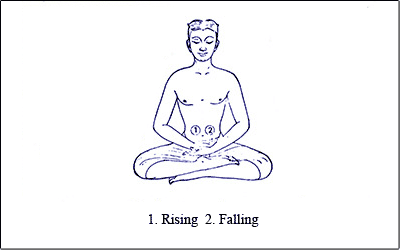
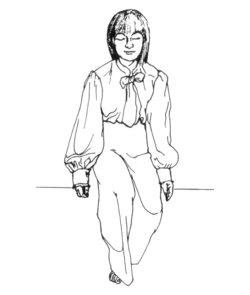

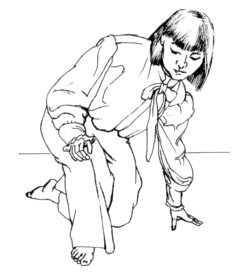
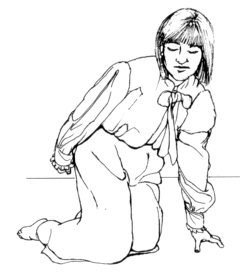
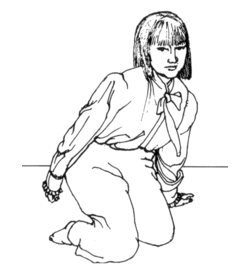
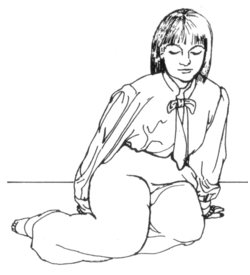
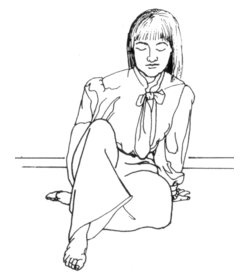
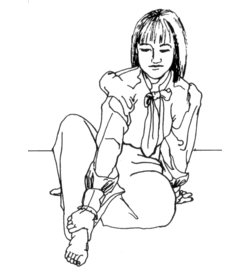
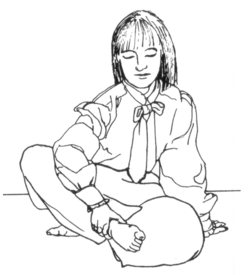
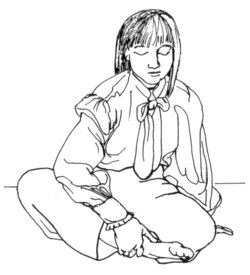
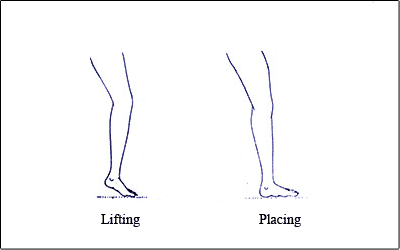
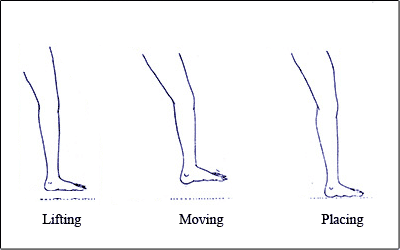
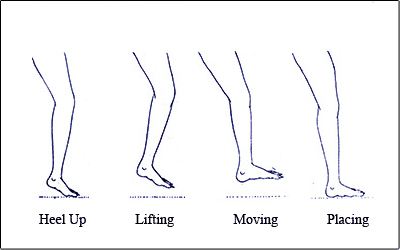
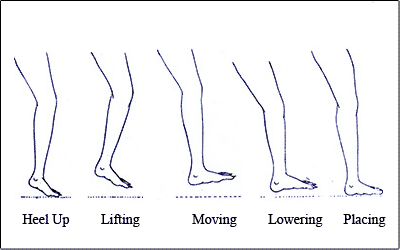
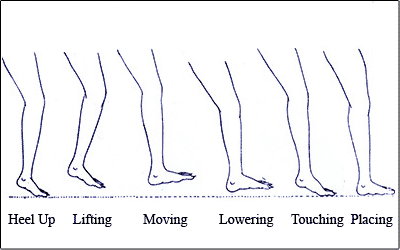
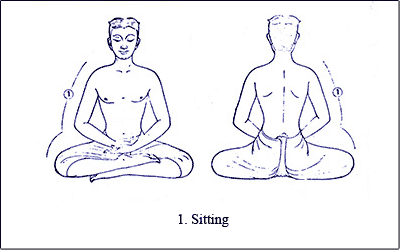
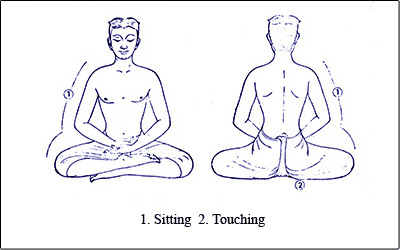
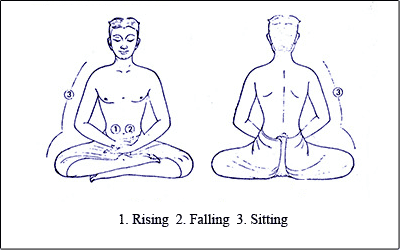
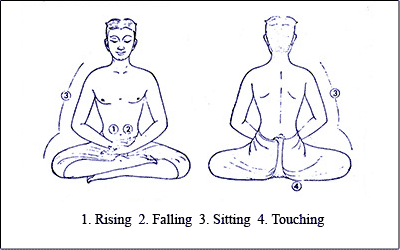
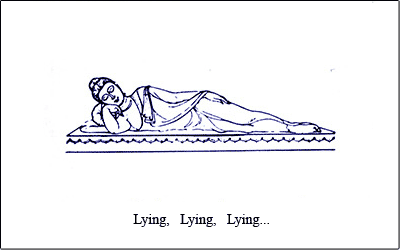
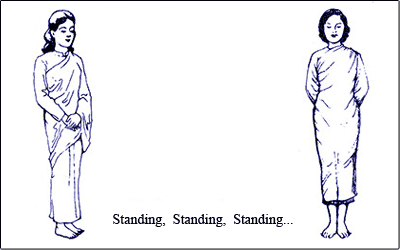
You must log in to post a comment.